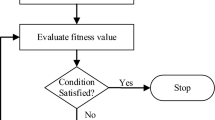Abstract
Holding strategies are among the most commonly used operation control strategies. This paper presents an improved holding strategy. In the strategy, a mathematical model aiming to minimize the total waiting times of passengers at the current stop and at the following stops is constructed and a new heuristic algorithm, shuffled complex evolution method developed at the University of Arizona (SCEUA), is adopted to optimize the holding times of early buses. Results show that the improved holding strategy can provide better performance compared with a traditional schedule-based holding strategy and no-control strategy. The computational results are also evidence of the feasibility of using SCE-UA in optimizing the holding times of early buses at a stop.
Similar content being viewed by others
References
Yu B, Lam W H K, Tam M L. Bus arrival time prediction at bus stop with multiple routes. Transportation Research Part C: Emerging Technologies, 2011, 19(6): 1157–1170
Osuna E E, Newell G F. Control strategies for an idealized public transportation system. Transportation Science, 1972, 6(1): 52–72
Abkowitz M, Eiger A, Engelstein I. Optimal control of headway cariation on trasit routes. Journal of Advanced Transportation, 1986, 20(1): 73–88
Dessouky M, Hall R, Nowroozi A, Mourikas K. Bus dispatching at timed transfer transit stations using bus tracking technology. Transportation Research Part C: Emerging Technologies, 1999, 7(4): 187–208
Dessouky M, Hall R, Zhang L, Singh A. Real-time control of buses for schedule coordination at a terminal. Transportation Research Part A: Policy and Practice, 2003, 37(2): 145–164
Zolfaghari S, Azizi N, Jaber M Y. A model for holding strategy in public transit systems with real-time information. International Journal of Transport Management, 2004, 2(2): 99–110
O’Dell S, Wilson N H M. Optimal real-time control strategies for rail transit operations during disruptions. Lecture Notes in Economics and Mathematical Systems, 1999, 471: 299–323
Lin G, Liang P, Schonfeld P, Larson R. Adaptive control of transit operations. Final Report for Project MD-26-7002, University of Maryland, 1995
Newell G F. The rolling horizon scheme of traffic signal control. Transportation Research Part A: Policy and Practice, 1998, 32(1): 39–44
Barnett A. On controlling randomness in transit operations. Transportation Science, 1974, 8(2): 102–116
Koffman D. A simulation study of alternative real-time bus headway control strategies. Transportation Research Record, 1978, 663: 41–46
Yu B, Yang Z. A dynamic holding strategy in public transit systems with real-time information. Applied Intelligence, 2009, 31(1): 69–80
Yu B, Yang Z, Yao J. Genetic algorithm for bus frequency optimization. Journal of Transportation Engineering, 2010, 136(6): 576–583
Duan Q, Sorooshian S, Gupta V K. Effective and efficient global optimization for conceptual rainfall-runoff models. Water Resources Research, 1992, 28(4): 1015–1031
Duan Q, Gupta V K, Sorooshian S. Shuffled complex evolution approach for effective and efficient global minimization. Journal of Optimization Theory and Applications, 1993, 76(3): 501–521
Duan Q, Sorooshian S, Gupta V K. Optimal use of the SCE-UA global optimization method for calibrating watershed models. Journal of Hydrology, 1994, 158(3–4): 265–284
Nelder J A, Mead R. A simplex method for function minimization. The Computer Journal, 1965, 7(4): 308–313
Price WL. Global optimization algorithm for a CAD workstation. Journal of Optimization Theory and Applications, 1987, 55(1): 133–146
Holland J H. Adaptation in Natural and Artificial Systems. Ann Arbor: University of Michigan Press, 1975
Yu B, Yang Z. An ant colony optimization model: the period vehicle routing problem with time windows. Transportation Research Part E: Logistics and Transportation Review, 2011, 47(2): 166–181
Nunoo C, Mrawira D M. Shuffled complex evolution algorithms in infrastructure works programming. Journal of Computing in Civil Engineering, 2004, 18(3): 257–266
Abdulhai B, Sheu J B, Recker W. Simulation of ITS on the irvine FOT area using “Paramics 1.5” scalable microscopic traffic simulator: phase I: model calibration and validation. California PATH Research Report UCB-ITS-PRR-99 99-12, 199
Sheu J B, Chou Y H, Chen A. Stochastic modeling and real-time prediction of incident effects on surface street traffic congestion. Applied Mathematical Modelling, 2004, 28(5): 445–468
Yu B, Yao J, Yang Z. An improved headway-based holding strategy for bus transit. Transportation Planning and Technology, 2010, 33(3): 329–341
Yu B, Yang Z, Cheng C. Optimizing the distribution of shopping centers with parallel genetic algorithm. Engineering Applications of Artificial Intelligence, 2007, 20(2): 215–223
Author information
Authors and Affiliations
Corresponding author
Additional information
Yu Jiang received her PhD from Southeast University, China, in 2007. Currently she is an assistant professor in the College of Civil Aviation, Nanjing University of Aeronautics and Astronautics, Nanjing, China. Her current research interests include artificial intelligence and intelligent transportation systems.
Shuli Gong received her BSc from Nanjing University of Aeronautics and Astronautics in 2005. Now she is an assistant professor in the College of Civil Aviation, Nanjing University of Aeronautics and Astronautics, Nanjing, China. Her primary research interests are traffic information engineering and control technology.
Rights and permissions
About this article
Cite this article
Jiang, Y., Gong, S. Bus holding strategy based on shuffled complex evolution method. Front. Comput. Sci. 6, 462–468 (2012). https://doi.org/10.1007/s11704-012-1097-z
Received:
Accepted:
Published:
Issue Date:
DOI: https://doi.org/10.1007/s11704-012-1097-z




